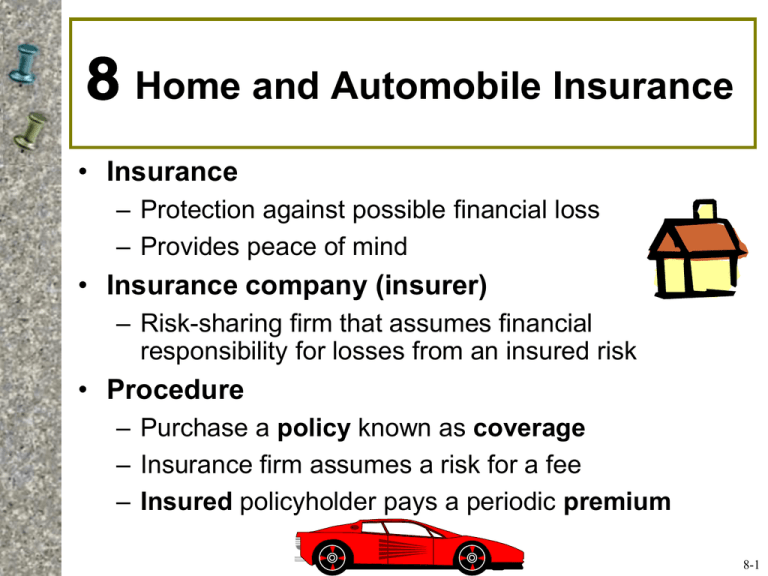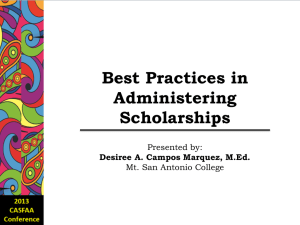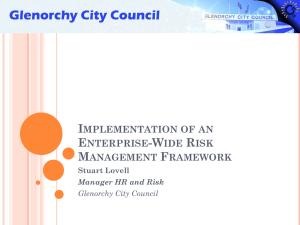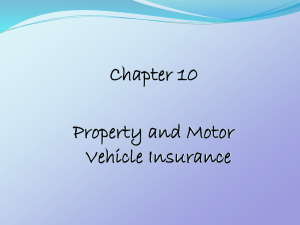
8 Home and Automobile Insurance
• Insurance
– Protection against possible financial loss
– Provides peace of mind
• Insurance company (insurer)
– Risk-sharing firm that assumes financial
responsibility for losses from an insured risk
• Procedure
– Purchase a policy known as coverage
– Insurance firm assumes a risk for a fee
– Insured policyholder pays a periodic premium
8-1
Objective 1
Identify Types of Risks and Risk Management Methods
and Develop a Risk Management Plan
• Risk
– Chance of loss or injury
– Uncertainty or lack of predictability
• Peril
– Anything that may cause a loss
– Fire, windstorm, robbery, or accidents
• Hazard
– Anything that increases the likelihood of a loss
– For example, driving drunk, defective house
wiring
8-2
Most Common Types of Risk
• Personal Risks
– Loss of income or life
– Caused by illness, disability, old age, or unemployment
• Property Risks
– Losses to property
– Caused by perils such as fire or theft
• Liability Risks
– Losses caused by negligence
– Resulting in injury or property damage
• Pure Risk = Insurable
– Accidental, unintentional
– Nature and financial loss of the risk can be predicted
• Speculative Risk = Uninsurable
– Chance of loss or gain
– Starting a small business, gambling, or investing
8-3
Risk
Avoidance
Risk
Shifting
Ways to
Manage
Risk
Risk
Reduction
Wear seatbelts
Buy Insurance
Self Insurance
Don’t stop at a
convenience store in
a bad part of town
after midnight
Risk
Assumption
Install an
alarm system
8-4
Planning an Insurance Program
1.
Set insurance goals to reduce possible loss of:
•
Income due to premature death, illness, accident or
unemployment
•
Property caused by perils
•
Income, savings and property due to personal negligence
2.
Develop a plan to reach your goals
•
What do you need to insure?
•
How much should you insure it for?
•
What kind of insurance should you buy?
•
Who should you buy insurance from?
3.
Put your plan into action
4.
Check your results
•
Insurance needs and goals change
8-5
Property and Liability Insurance
• Potential property losses
– Home, automobiles, furniture, clothing, personal belongings
– Risk #1: Physical damage caused by perils (e.g., fire)
– Risk #2: Loss or damage caused by criminal behavior
• Liability = legal responsibility for the financial cost of another
person’s losses or injury (if you are held legally liable)
• Liability due to negligence
– Failure to take ordinary and reasonable care
• Vicarious Liability
– You are held responsible for the actions of another person, such
as your child throwing a ball through a neighbor’s window
8-6
Objective 2
Assess the Insurance Coverage and
Policy Types Available to Homeowners
and Renters
Homeowner’s Insurance Coverage
– Damage or destruction of the building in
which you live, and other structures on
the property
• Garage, tool shed, trees, and shrubs
– Additional Living Expenses
• May be limited to 20-30% of property value
• May be limited to 6-9 months
8-7
Homeowner’s Insurance Coverages
– Personal Property
• Furniture, appliances and clothing
• Household inventory advisable
• Usually 55%, 70%, or 75% of property value
• Limits on certain items such as jewelry
– Personal Liability and Related Coverage
• Covers injuries to others on property (e.g., fall on ice)
– Specialized Coverage
• Earthquake endorsement
• Flood coverage
8-8
Homeowner’s Insurance Coverages
• Medical Payments Coverage
– Coverage for minor injuries caused by you,
your family members, or pets, occurring on
your property or away from home
• Personal Liability Coverage
– Umbrella policy - also called a personal
catastrophe policy
– Supplements basic personal liability coverage
– $1,000,000 or more in coverage
• Endorsements and Floaters
– Endorsements add coverage
– Personal property floater
• Covers specific items of high value
• Jewelry, furs, art collections
8-9
Renter’s Insurance
• Broad Form
– Covers personal property loss or damage
specified in the policy
• Comprehensive Form
– Protects property against all perils not excluded
• Renter’s insurance is relatively inexpensive
– Replacement value coverage more costly
– Covers property only in your home
– Usually includes liability coverage
• Many renters do not have insurance
8-10
Home Insurance Policy Forms
• Basic Form (HO-1)
– Protects against perils such as fire, lightning, windstorms, hail, smoke,
theft, vandalism and riots (specific named perils)
• Broad Form (HO-2)
– Wider coverage including falling objects and damage from ice, snow or
sleet (more specific named perils)
• Special Form (HO-3)
– Basic + Broad form + all other risks unless specifically excluded
(commonly earthquake, flood, nuclear accidents, business usage)
• Tenant’s Form (HO-4)
– Covers personal property against listed risks
• Comprehensive Form (HO-5)
– Expands HO-3 coverage to replacement cost; increasingly rare!
• Condominium Owner (HO-6)
– Covers personal property and building additions
8-11
Objective 3
Analyze the Factors that Influence the
Amount of Coverage and Cost of Home
Insurance
• Determine amount of coverage needed:
– Replacement value of home ?
– Value of home’s contents ?
– Protection for specific items ? (Jewelry, furs, art)
– Liability coverage ?
• Consider “loss frequency” (likely # of times for loss) and
“loss severity” (potential magnitude of a loss)
• Principle of Indemnity- insurance will pay no more than
actual financial losses suffered
• Policy Limits- specify the maximum dollar amounts that
will be paid under a policy
8-12
Policy Provisions
• Look for a policy with full coverage (100% value)
– Coinsurance clause requires you to pay a part
of a loss.
• Claim settlement methods:
– Actual Cash Value (ACV)
• Replacement cost less depreciation
– Replacement Cost
• Full cost to repair or replace the damaged or
lost item
• 10-20% > actual cash value coverage
8-13
Factors That Affect Home
Insurance Costs
• Location of Home (e.g., rural vs. urban)
• Type of Structure (e.g., brick vs. wood)
• Coverage Amount and Policy type
• Home Insurance Discounts
– Alarm system
– Smoke detectors
– If you insure car with the same company
• Company Differences
– Compare costs and coverages
8-14
Objective 4
Identify the Important Types of
Automobile Insurance Coverage
• Financial Responsibility Law
– State legislation requiring proof of financial
ability to cover the cost of damage or injury
caused in an automobile accident
– 45 states have compulsory automobile
liability insurance laws
– NJ has very low liability limits:15/ 30/5
8-15
Motor Vehicle Bodily
Injury Coverage
• Bodily Injury Liability
– Covers financial loss due to legal expenses, medical
expenses, lost wages, etc. associated with injuries
caused by an accident for which you were
responsible
– Expressed as 3 numbers: 100/300/50
• Maximum coverage in $1,000’s
• $100,000 maximum paid for injuries to any one
person
• $300,000 maximum paid in total (2+ people)
• $50,000 maximum paid for property damage
8-16
Motor Vehicle Bodily
Injury Coverage
• Medical Payments Coverage
– Covers the cost of health care for persons injured in your
automobile, including yourself
– Also covers you or family members injured while riding in
or hit by another vehicle
• Uninsured Motorist’s Protection
– Protection against the risk of getting into an accident with
someone with no insurance
• Underinsured Motorist’s Coverage
– Pays costs if your car is hit by a person who doesn’t have
enough insurance to cover the damage they did to you and
your car
8-17
Motor Vehicle Property
Damage Coverage
Property Damage Liability
– Covers damage to the other person’s car
when you are at fault.
– Includes damage to such things as street
signs, telephone poles, and buildings
• Example: during a snow storm you accidentally
slide your vehicle into a neighbor’s mailbox. This
coverage would pay for repair or replacement of
the mailbox
8-18
Collision Coverage
Pays for damage to your automobile,
regardless of who is at fault.
– If you are not at fault, your insurer will try to
collect from the other driver’s property
damage liability first.
– Coverage limited to the retail value of your
vehicle
8-19
Comprehensive Physical Damage
Covers damage to your vehicle not
caused by a collision, such as:
– Fire, theft or vandalism
– Glass breakage
– Hail, sand, or wind storm
– Falling objects or hitting an animal
8-20
No-Fault Insurance
• Each driver collects from his or her own
insurance company for medical expenses,
lost wages, and related injury costs
• 30 states have some variation of the system
• Intended to provide fast, smooth method of
paying for damages without determining fault
• Variations among states; designed to reduce
cost and time to settle cases
8-21
Objective 5
Evaluate Factors that Affect the Cost of
Automobile Insurance
Automobile Insurance Costs
• Legal Concerns
– Have enough coverage if you are sued
– Recommendations:
• $100,000/$300,000 bodily injury liability
• Additional $1,000,000+ umbrella liability policy
• Property Values
– $50,000-$100,000 suggested for property
damage liability
8-22
Motor Vehicle Insurance
Premium Factors
• Vehicle Type
– Year, make, model, and theft rate
• Rating Territory
– Accident, auto theft, and vandalism rates in the area where you live
• Driver Classification
– Age, sex, marital status, credit history, driving record, driving habits
– Assigned risk pool for those unable to obtain insurance
Reducing Automobile Insurance Premiums
• Compare Companies
• Premium Discounts
–
–
–
–
–
Establish and maintain a good driving record
Non-smoker
Install security devices such as a car alarm
If more than one vehicle, insure with the same company
Larger deductibles
8-23
Wrap Up
• Chapter Quiz
• Concept Check 8-1- Four Methods of Avoiding
Risk with Examples
• Concept Check 8-2- Complete the Statements
• Concept Check 8-3- True of False?
• Concept Check 8-4- True or False?












